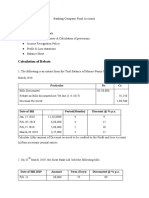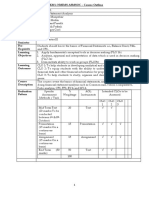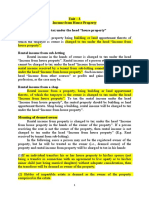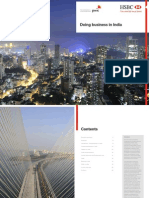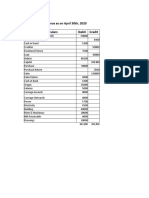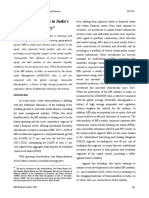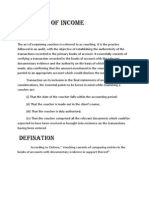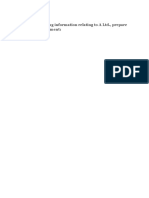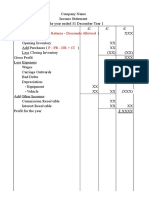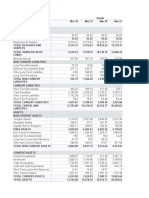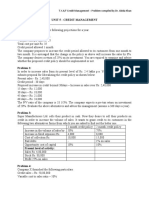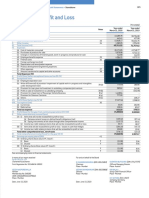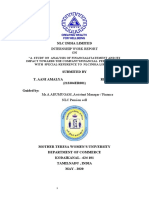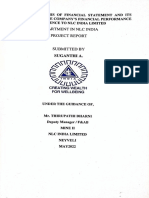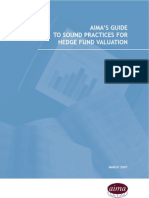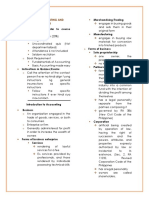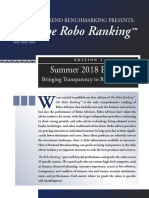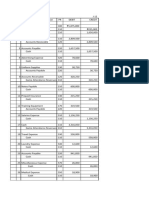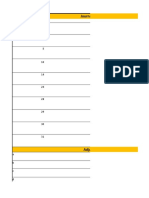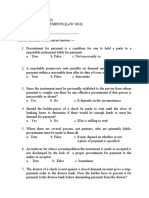NLC INDIA LIMITED
INTERNSHIP WORK REPORT
ON
“A STUDY ON ANALYSIS OF FINANCIALSTATEMENT AND ITS
IMPACT TOWARDS THE COMPANY'SFINANCIAL PERFORMANCE
WITH SPECIAL REFERENCE TO NLCINDIA LIMITED"
SUBMITED BY
K. SUMITHRA (Reg.213304ER005)
Guided by:
Mr.A.ARUMUGAM ,Assistant Manager / Finance
NLC Pension cell
MOTHER TERESA WOMEN’S UNIVERSITY
DEPARTMENT OF COMMERCE
KODAIKANAL - 624 101
TAMILNADU , INDIA
MAY - 2020
I
�A STUDY ON ANALYSIS OF FINANCIAL STATEMENT
AND ITS
IMPACT TOWARDS THE COMPANY'S FINANCIAL
PERFORMANCE
WITH SPECIAL REFERENCE TO
NLC INDIA LIMITED
DEPARTMENT IN NLC INDIA
INTERNSHIP REPORT
SUBMITTED BY
SUMITHRA .K
UNDER THE GUIDANCE OF
Mr.A.ARUMUGAM
Assistant Manager / Finance
NLC Pension cell
NLC INDIA LIMITED
NEYVELI
II
� MAY - 2022
NLC INDIA LIMITED
("NAVRATNA"- GOVERNMENT OF INDIA ENTERPRISE)
NEYVELI, TAMILNADU
BONAFIDE CERTIFICATE
Certified that the internship "A STUDY ON ANALYSIS OF FINANCIAL
STATEMENT AND ITS IMPACT TOWARDS THE COMPANY'S
FINANCIAL PERFORMANCE WITH SPECIAL REFERENCE TO NLC
INDIA LIMITED" is the Bonafide work of, Miss. SUMITHRA .K, (Reg no:
213304ER005) pursuing M.com (Integrated) fist year, a Internship work done during the
period from 23.05.2022 to 30.05.2022 at Finance & Accounts Branch, Mine-II, NLCIL
Neyveli. Their performance, conduct and attendance during the period were found to be good.
PLACE : NEYVELI
DATE : -05-2022
SIGNATURE OF GUIDE
III
� NLC INDIA LIMITED
"NAVRATNA"- A GOVERNMENT OF INDIA ENTERPRISES
NEYVELI-607 801 TAMILNADU
CERTIFICATE
This is to certify that this internship report on "A STUDY ON ANALYSIS OF
FINANCIAL STATEMENT AND ITS IMPACT TOWARDS THE COMPANY'S
FINANCIAL PERFORMANCE WITH SPECIAL REFERENCE TO NLC INDIA
LIMITED" is a Bonafide internship report work done by Miss. SUMITHRA.K,
(Reg. no: 213304ER005) pursuing M.com ( Integrated) Fist year, MOTHER TERESA
WOMEN’S UNIVERSITY, ATTUVAMPATTY, KODAIKANAL - 624 101 during the
period from 23.05.2022 to 30.05.2022 at Finance & Accounts Branch, Mine-II, NLCIL
Neyveli.
EXTERNAL GUIDE
Permitted to submit the internship work report to college/university authorities.
PLACE : NEYVELI
DATE :
DEPUTY CHIEF MANAGER/HR,
LEARNING AND DEVELOPMENT CENTRE,
NLC INDIA LIMITED, NEYVELI
IV
� DECLARATION
I hereby declared that the internship work entitled "A STUDY ON ANALYSIS OF
FINANCIAL STATEMENT AND ITS IMPACT TOWARDS THE COMPANY'S
FINANCIAL PERFORMANCE WITH SPECIAL REFERENCE TO NLC INDIA
LIMITED, NEYVELI", submitted to department of Commerce in
MOTHER TERESA WOMEN’S UNIVERSITY, ATTUVAMPATTY, KODAIKANAL
for the degree of Master of Commerce (Integrated) in a reward of
original work done by myself under the guidance of Mr. A. ARUMUGAM, Assistant
manager / Finance, NLC Pension cell, NLC INDIA LIMITD NEYVELI .
This internship report is for reference only and no part of the report will be published of copied
anywhere without the written permission from officials of NLCIL, Neyveli.
Signature of the
student
(SUMITHRA .K)
V
� ACKNOWLEDGEMENT
I wish to thank the eminent personalities who served as a backbone for the
success of this internship apart from the efforts taken by me.
I express my sincere thanks to NLC - India Limited for providing me the
opportunity to carry out the internship.
I sincerely thank Shri. MATHEW KOSHYGM / L&D , Learning &
Development Centre , Dr. GANESH N DCM/HR , Mr. KALYANA SUNDRAM
J.E./E Learning & Development Centre for his kind patronage and for all the
facilities offered to do this internship successfully.
With deep sense of gratitude , I immensely thank my guide
Mr. A. ARUMUGAM, Assistant manager/ Finance , NLC Pension cell, for his
guidance and wonderful support to carry out this internship under his
effective supervision , guidance , encouragement and co- operation.
I would have never succeeded in completing my internship work without the
co-operation and technicians, and other personalities of Mine-II.
VI
� ABSTRACT
The main objective is to analyse the financial statement and its impact towards
the Company's financial performance with special reference to NLC INDIA
LIMITED. This present study was undertaken with an aim to underneath the
strength and weakness of the financial Performance in NLC INDIA LIMITED.
The assessment of an organization shows how efficient and stable was those
financial decisions by using the ratio analysis and Comparative balance sheet
statement. Thus it becomes a critical part of financial management. This study also
assesses the impact towards the company's financial performance . This lead us
to the topic of “ A STUDY ON ANALYSIS OF FINANCIAL STATEMENT
AND ITS IMPACT TOWARDS THE COMPANY'S FINANCIAL
PERFORMANCE WITH SPECIAL REFERENCE TO NLC INDIA”.
TABLE OF CONTENT
VII
�CHAPTE PARTICULARS PAGE N0
R
NO
1 INTRODUCTION
1.1Finance 1
1.2Importance 1
1.3Financial statement analysis 2
1.4Definition 2
1.5 FINANCIAL TOOLS 3
1.6 NEED OF THE STUDY 3
2 INTRODUCTION OF THE COMPANY
2.1 Introduction of the Industry 4 -5
2.2 Company profile 6
2.3 Units in the company 7-8
3 RESEARCH METHODOLOGY
3.1 Research design 9
3.2 Data collection 9
33 Financial tools used 9
3.3.1 Ratio analysis 10
3.3.2 Comparative balance sheet 14
DATA ANALYSIS AND 20
INTERPRETATION
4 CONCLUSIONN 21
REFERENCE 22
VIII
� CHAPTER - 1
INTRODUCTION
1.1 INTRODUCTION OF FINANCE
Finance is a system that involves the exchange of funds
between the borrowers and the lenders and investors. It
operates at various levels from firms to global to
national levels. Thus, there are many complexities
involved in it related to markets, institutions, etc.
1.2 IMPORTANCE OF FINANCE
* Finance is life blood of business
* It is a pre requisite to mobilize resource for organizing
industrial production
* It is also necessary for developing infrastructure of
any country, roads,Railways,electricity,ports,
residential and commercial constructions
etc.
* Finance is also needed in agriculture ,for purchasing
seeds, fertilizers,
Farm equipment, storage capacities etc.
1
�1.3 FINANCIAL STATEMENT ANALYSIS
Financial statement analysis is the process of analyzing a
company's financial statements for decision-making
purposes. External stakeholders use it to understand the
overall health of an organization as well as to evaluate
financial performance and business value
1.4 DEFINITIONS OF FINANCE
Finance, of financing, is the process of raising funds or
capital for any kind of expenditure. It is the process of
channeling various funds in the form of credit, loans, or
invested capital to those economic entities that most
need them or can put them to the most productive use.
2
� 1.5 FINANCIAL TOOLS
The financial tools below are essential to running your
business, spanning areas from accounting to expense
management to budgeting and more.
* Accounting Software.
* Expense Tracking.
* Budgeting Tools.
* Payroll Management.
* Easy Billing.
* Inventory Tracking.
* Tax Preparation.
1.6 NEED OF THE STUDY
* To analyze the financial statement of the company.
* To understand the financial position of the company.
* To evaluate their performance in future by computing
various
financial tools for the past 5 years data.
3
� CHAPTER - 2
2.1 INTRODUCTION OF THE COMPANY
Lignite deposit was a chance finding when some "brown
substance' gushed out with water in Rao Bahadur M.
Jambulingam Mudaliar's 620acre own farm artesian
well during 1934. He acted swiftly and contacted the
then British Raj, which sent geologists to Neyveli. It was
later identified as Lignite'. He generously extended
substantial portion of the sprawling and-bank for soil
exploration. Through his effort and donated his 620 acres
land to the Madras Government. NLC has been a
forerunner in the country in the energy sector for 62
years, contributing a lion's share in lignite production and
significant share in thermal power generation. It was
inaugurated by the first Prime Minister Jawaharlal
Nehru in 1956.
NLC operates four opencast lignite mines of a total
capacity of 30.6 million tonnes per annum (MTPA) at
Neyveli and Barsingsar; Six lignite
based pithead thermal power stations with an aggregate
capacity of 3640 MW at Neyveli and Barsingsar; and a
1000MW coal based thermal power Station at
Thoothukudi, Tamil Nadu through its subsidiary, NLC
Tamil Nadu Power Limited (NTPL), a jointventure
between NLC and TANGEDCO (equity participation in
the ratio of 89:11). NLC recently commissioned a 1x500
4
�MW unit at Neyveli which is also Asia’s largest ignite
fired boiler.
NLC has also forayed into renewable energy sector with
commissioning of a 141 MW Solar Photo Voltaic Power
Plant including 1 MW rooftop project at Neyveli and a
51MW wind energy plant at Kazhuneerkulam village of
Tirunelveli district in Tamil Nadu. The Company is also
setting up 1209 MW Solar Power Projects at Tirunelveli,
Virudhunagar and Ramanathapuram districts of Tamil
Nadu, of which, 300 MW have been commissioned.
NLC is aiming to achieve a total renewable energy
capacity of 4251 MW.
NLC has also contributed significantly to the socio-
economic development for more than half a century
5
�2.2 COMPANY PROFILE
NLC India Limited (NLC) (formerly Neyveli Lignite
Corporation India Limited)is a Navratna government
corporation in the fossil fuel mining sector in India and thermal
power generation under the ownership of Ministry of Coal,
Government of India.
Company name - Neyveli Lignite Corporation
Company location - Block-1, NLC Township ,Neyveli,Cuddalore.
Company status - Active
Company category - Company limited by shares
Company sub category - Government Corporation
Registration number - 3507
Headquarters - Neyveli, Tamil Nadu, India
Of Employee - 11,454
Type of company - Government Corporation
Website - https://www.nlcindia.com
Industry - Lignite mining, Power generation, Wind & Solar
power
Estate Turnover - 1211.41 Crore.
2.3 COMPANY VISION:
* To emerge as a leading Mining and Power Company with
Social responsiveness accelerating Nation's growth.
6
�2.4 COMPANY MISSION:
* Promoting adherence to value based culture.
* Develop and sustain expertise in power and mining with
focus on growth and
Financial strength.
* Encouraging/ creating an atmosphere of continual learning
and competency
building.
* Devising/ Upgrading HR Systems to support organizational
goals
2.4 COMPANY VALUES:
N - National Orientation
L - Learning and Development
C - Commitment for Excellence
2.5 COMPANY ADDRESSES OF NLCIL HEAD QUARTERS & REGISTERED
OFFICE:
HEADQUARTERS: REGISTEREDOFFICE:
Corporate Office, First Floor,
NLC India limited, #8 Mayor Sathiyamurthy Road
Corporate Office, FSD, Egmore Complex of
Block-1,Neyveli-607 801. Food Corporation of India,
Cuddalore District (TN). Chetput Chennai-600031.(TN)
7
�2.6 VARIOUS UNIT'S OF TIE COMPANY:
* Mine-l Mine1A, Mine2
* Thermal Power station I, EXPN, TPS2
* Solar power plant
* Wind Power
2.7 STRENGTH :
Diversified energy portfolio of Fossil Fuel Mining, Thermal Power Generation &
Renewable Power.
Expertise in lignite & coal fired power station.
Expertise in renewable power generation and power trading.
Experienced Management team with committed and experienced work force.
Having Pit Head Power Stations.
Availability of lignite, coal and water for power generation.
Expertise in open-cast lignite mining with SME technology.
Strong capabilities for exploration, mine planning, Research & Development.
Harmonious industrial relations.
Strong track record of growth and financial performance.
Expertise in ground water management.
2.6 OPPORTUNITIES:
Investment in promoting Green Energy
Government of India's (Gol) commitment to improve the quality of life of its
citizens
through higher electricity consumption.
Rise in the per capital consumption of power.
Trading of Power in the Market.
Launch of 100 smart cities mission by Gol.
8
� CHAPTER -3
RESEARCH METHODOLOGY
A research methodology is an outline of how a given piece of research is
carried out. It defines the techniques or procedures that are used to
identify and analyse information regarding a specific research topic.in a
research paper, the
3.1 RSEARCH STRUCTURE
The research design used in this project uses the process that is naturally
analyzed. Researchers should use existing facts or information and
analyze these to make a critical evaluation of the performance.
3.2 Data collection
Secondary data: Secondary data is the data that have been already
collected by and readily available from other sources.
Company balance sheet
Company website
Books and Journals pertaining to the topic
3.3 Financial tools used
Ratio analysis
Comparative balance sheet statement
9
�3.3.1 RATIO ANALYSIS
1. Ratio:
Ratio is a "mathematical expression of relationship between
two related items expressed in a quantitative form.
2. RATIO ANALYSIS
Ratio analysis is much different. Ratio analysis compares
relationships between financial statement accounts. This
means that one income statement or balance sheet account is
being compared to another. These relationships between
financial statement accounts will not only give a manager or
investor an idea of the how healthy the business is on a whole,
it will also give them keen insights into business operations.
3. Functional Classification:
The following are the common types of measures used in
ratio analysis:
Profitability ratios
Solvency ratios
Turnover ratios
10
� PROFITABILITY RATIO:
Profitability ratios are a class of financial metrics that are used
to assess a business's ability to generate earnings relative to its
revenue, operating costs, balance sheet assets, or shareholders'
equity over time, using data from a specific point in time.
Common profitability ratios include
Net profit
Net profit ratio is a measure of management's efficiency in operating the
business successfully from the owner's point of view. It reveals the
remaining profit after all costs of production, administration, and
financing have been deducted from sales, and income taxes recognized.
Net profit ratio = Net profit(PAT) / sales * 100
Return on net worth
Return on net worth (RONW) is used in finance as a measure of a
company's profitability. It reveals how much profit a company generates
with the money that the equity shareholders Have invested. Return on net
worth (RONW) Is used in finance as a measure of a company's
profitability.
Return on net worth= Profit after tax / shareholder fund
Return on total resources
The return on total assets ratio compares a company's total assets with the
amount of money it returns to its shareholders. It is one of five ratios used
to assess a company's profitability with return on shareholders' equity,
gross profit margin ratio, return on common equity and along
net profit margin ratio.
Return on total resources = Net profit / Total assets
11
� SOLVENCY RATO:
A solvency ratio is a key metric used to measure an enter prises ability to
meet its long-term debt obligations and is used often by prospective
business lenders . A solvency ratio indicates whether a company's cash
flow is sufficient to meet its long-Term liabilities and thus is a measure of
its financial health.
Current ratio
The current ratio is a liquidity ratio that measures a company's ability to
pay short-term Obligations or those due within one year. It tells investors
and analysts how a company can maximize the current assets on its
balance sheet to satisfy its current debt and other payables.
Current Ratio = Current Assets/ Current Liabilities
Liquid ratio
It's a ratio that tells one's ability to pay off its debt as and when they
become due. In other Words, we can say this ratio tells how quickly a
company can convert its current assets into Cash so that it can pay off its
liability on a timely basis
Liquid ratio= Quick Assets/ Current Liability
Fixed asset ratio
Fixed Assets ratio is a type of solvency ratio (long-term solvency) which
is found by dividing total fixed assets (net) of a company with its long-
term funds. It shows the amount of fixed assets being financed by each
unit of long-term funds
Fixed Assets ratio = Fixed Assets/Long term fund
12
� Proprietary ratio
The proprietary ratio (also known as the equity ratio) is the proportion of
shareholders' equity to total assets, and as such provides a rough estimate
of the amount of capitalization currently used to support a business.
Proprietary ratio = Proprietor's funds/ Total assets
TURNOVER RATIO:
The turnover ratio or turnover rate is the percentage of a Mutual
fund or other portfolio's holdings that have been Replaced in a
given year (calendar year or whichever 12-month period represents
the fund's fiscal year).Turnover ratios used are Asset turnover ratio and
working capital turnover ratio.
Asset turnover ratio
The asset turnover ratio measures the value of a company's sales or
revenues relative to the value of its assets. The asset turnover ratio can be
used as an indicator of the efficiency With which a company is using its
assets to generate revenue.
Asset turnover rati0 = Net sales/ Total asset
13
� Working capital turnover ratio
A working capital turnover ratio is most commonly used
to determine a company's financial performance and
analyze its overall operations. It can also be used to see if
a company will be able to pay off debt in a set period and
avoid running out of cash as a result of increased
production requirements.
Working capital turnover ratio = net sales / working
capital
3.3.2 COMPARATIVE BALANCE SHEET STATEMENT
The comparative balance sheet is a balance sheet that
provides financial figures of assets, liabilities, and equities
for “two or more periods of the same company,” or “two or
more subsidiaries of the same company” or “two or more
companies of the same industry” in the same format so that
it can be easily understood .
comparative statement presents the results of multiple
accounting periods in separate columns.
14
� Working capital
Working capital is the most important component of a
business that represents the liquidity available to a
business enterprise for managing day-to-day operations.
This helps a financial manager or a business owner to
know about the liquidity position of the business.
changes in Long-Term Assets, Liabilities, and Capital
The next component that a financial manager or a
business owner needs to analyze is the change in the
fixed assets, long-term liabilities and capital of a
business. This analysis helps each of the stakeholders to
understand the long-term financial position of a
business.
15
� The following points should be studied when analyzing a
comparative balance sheet
1. The present financial and liquidity position (study working
capital).
2. The financial position of the business in the long term.
3.The profitability of the business.
this format allows the reader to compare the results of
multiple historical periods.
thereby, it gives a view of how a business is performing
overtime
16
� THE FORMAT OFComparative
A COMPARATIVE
BalanceBALANCE
Sheet SHEET
Particulars Previous Current Absolute Percentage Change
Change (Increase of
Year(Rs) Year(Rs) (Increase of Decrease)
Decrease) (Rs)
(%)
I. I.EQUITY AND LIABILITIES .… …. ….
….
1. Shareholders’ founds
…. …. .… ….
(a) Share Capital
…. …. …. ….
(i) Equity Share Capital
…. …. …. ….
(ii) Preference Share Capital
(b) Reserves and Surplus …. …. …. ….
2. Non-current Liabilities
(a) Long-term Borrowings …. …. …. ….
(b) Long-term provisions …. …. …. ….
3. Current Liabilities
…. …. …. ….
(a) Short-term Borrowings
…. …. …. ….
(b) Trade Payables
…. …. …. ….
( c) Other Current Liabilities …. …. …. ….
(d) Short-term Provisions
Total …. …. …. ….
II. ASSETS
1. Non- current Assets
(a) Fixed Assets
…. …. …. ….
…. …. …. ….
(i) Tangible Assets
…. …. …. ….
(ii) Intangible Assets …. …. …. ….
(b) Non-current Investments …. …. ….
….
(c)Long-term Loans and …. …. …. ….
Advances
3. Current Assets
(a) Current Investments …. …. …. ….
(b) Inventories …. …. …. ….
(c) Trade Receivables …. …. …. ….
(d) Cash and Cash Equivalents …. …. …. ….
(e) Short -term Loans and Advances …. …. …. ….
(f) Other Current Assets …. …. …. ….
TOTAL
…. …. …. ….
17
� DATA ANALYSIS AND INTERPRETATION
3.4 Calculation of net profit ratio
PARAMETERS 2015-2016 2016-2017 2017-2018 2018-2019 2019-2020
Net profit 228.00 2368.82 1848.78 1266.97 1413.85
Sales 6652.05 8672.84 8496.20 7145.92 7916.30
Net profit ratio 3.43% 27.76% 21.76% 17.73% 17.86%
Working Notes 01:
Net profit = Net Profit/ Sales *100
2016 2017 2018
228.00/6652.05*100=3.43% 2368.82/8672.84*100=27.76% 1848.78/8496.20*100=
21.76%
2019 2020
1413.85/7916.30*100=17.73% 1848.78/8496.20*100=17.86%
10000
9000 8672.84 8496.2
7916.3
8000
7145.92
7000 6652.05
6000
5000
4000
3000 2368.82
1848.78
2000 1413.85
1266.97
1000
228 0.0343 0.27319 0.2176 0.1773 0.1786
0
2015-2016 2016-2017 2017-2018 2018-2019 2019-2020
Net Profit Sales Net Profit Ratio
Fig 3.4 Shows the net profit ratio
Inference:
he above table shows that the net profit ratio was high in the period of
2016-2017 with 27.31% and low in the period of 2015-2016 with 3.43%.
After 2017-2018 the net profit ratio tends to be decreased. In 2020 it was
increased than previous year to 17.860. This trend of net profit ratio WS
18
�that profit has increased and it has given more than 15% of Earnings to
respective previous financial years.
3.5 Calculation of return on net worth ratio
PARAMETERS 2015-2016 2016-2017 2017-2018 2018-2019 2019-2020
Profit after tax 228.00 2368.82 1848.78 1266.97 1413.85
Shareholder fund 1677.71 1528.57 528.57 1386.64 1386.64
Return on net 0.14% 1.55% 0.21% 0.91% 1.02%
worth ratio|
Working Notes 01:
2016 2017 2018
228.00/1677.71*100=0.14% 2368.82/1528.57*100=1.55% 1848.78/528.57*100=0.21%
2019 2020
1413.85/1386.64*100=0.91% 1848.78/1386.64*100=1.02%
2500
2000
1677.71
1528.57 1528.57
1500 1386.64 1386.64
2368.82
1000 228 1848.78
1266.97 1413.85
500
0 0.0014 0.0155 0.012 0.0091 0.0102
2015-2016 2016-2017 2017-2018 2018-2019 2019-
20200
Profit after tax Shareholder fund
Return on net worth ratio| 0.14%
Fig 3.5 Calculation of return on net worth ratio
Inference:
the above table shows that the return on net worth ratio was high in the period of 2016-2017
With 1.55% and low in the period of 2015-2016 with 0.14%, At 2019-2020 the return on net
worth ratio tends to be increased as 1.02% than previous year, Here it shows that from net
worth of the company they are getting at least 0.5% to 1.5% net profit in respective financial
years
19
�3.6 Calculation of return on total resources ratio
PARAMETERS 2015-2016 2016-2017 2017-2018 2018-2019 2019-2020
Net profit 228.00 2368.82 1848.78 1266.97 1413.85
Total Asset 23670.06 27509.38 32506.41 34506.41 39119.09
Return on total 0.01% 0.09% 0.06% 0.04% 0.04%
Resources ratio
Working Notes 01:
2016 2017 2018
228.00/23670.06*100=0.01% 2368.82/27509.38*100=0.09% 1848.78/32506.41*
100= 0.06%
2019 2020
1266.97/34506.41*100=0.04% 1413.85 /39119.09*100=0.04%
Working Notes 03:
45000
40000 39119.09
34682.34
35000 32506.41
30000 27509.38
25000 23670.06
20000
15000
10000
5000 2368.82 1848.78 1266.97 1413.85
2280.0001 0.0009 0.0006 0.04 0.0004
0
2015-2016 2016-2017 2017-2018 2018-2019 2019-2020
Net Profit Total Asset Return on total resourcesratio
Fig 3.6 shows the return on total resources ratio
Inference:
The above table shows that the return on total resources ratio was high in the period of
2016- 2017 with 0.09% and low in the period of 2015-2016 with 0.01%. At 2019-
2020 the return on On ratio tends to be equivalent with previous year as 0.04%.Here it
shows that company setting lower rate of profit from its respective fixed assets which
20
�defines that they are more conscious about working capital from which they are
getting good return
CHAPTER - 4
4.1 CONCLUSION
After analyzing the last five years financial data of NLC India
Limited. I concluded that NLCIL is one of the leading Mining
and Power Generation Company of Tamil nadu with a various
production capacity and input (Lignite and Coal) and it is a self-
solvent company with a strong leading position in the power
sector. Physical performance of NLC India Limited, for
production of Lignite, generating Power, shows always
increasing and record able growth. The Overall financial
performance was satisfactory, good and effective which helps
the company to run for long term. Almost all of the ratios of
NLCIL's show that they are solvent enough and it have the
efficiency to grow fur
21
�4.2 REFERENCE
FINANCIAL ACCOUNTING BOOK (T.S. REDDY &
DR.A.MURTHY)
NLCIL Website.
NLC ANNUAL REPORT BOOK (2016-2020)
FINANCIAL ACCOUNTING BOOK (Jain S.P , Narang K.L.)
22

